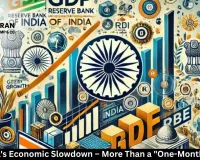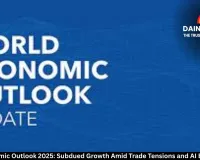Global Recession Fears Ease, but India Must Navigate Tariff Turbulence with Strategic Prudence
Digital Desk
The specter of a global economic downturn has diminished significantly, with financial institutions revising their recession probability estimates downward, yet the road ahead remains fraught with challenges that demand careful policy calibration and economic resilience, particularly for emerging economies like India.
J.P. Morgan Research has reduced its U.S. and global recession probability to 40% from earlier elevated projections, marking a notable shift in sentiment following the de-escalation of trade tensions between the United States and China.
The recent backtrack on aggressive U.S.-China tariffs has fundamentally altered economic outlooks, with the tariff tax burden now estimated at $430 billion worth 1.4% of U.S. GDP, down from more catastrophic projections.
However, the research firm warns that material headwinds will keep U.S. growth weak through the remainder of 2025, with GDP expansion projected at a meager 0.25% annualized rate in the second half.
Federal Reserve's Delayed Rate Cut Strategy
The Federal Reserve's monetary policy trajectory has undergone recalibration in response to these evolving dynamics. J.P. Morgan economists now anticipate the Fed will maintain policy rates steady through November, postponing rate cuts until December 2025.
This represents a significant delay from earlier September projections, reflecting the central bank's cautious approach to balancing labor market vulnerabilities against persistent inflation pressures. Following December, analysts expect three sequential cuts taking the funds rate target range to 3.25-3.5% by the second quarter of 2026.
Michael Feroli, chief U.S. economist at J.P. Morgan, noted that the updated labor market outlook is "less demanding of immediate action to stem employment risks," justifying the postponement. Financial markets have fully priced in two more rate cuts this year, with traders showing greater conviction than economists regarding the pace of monetary easing.
India's Complex Position in Global Economic Crosscurrents
From an Indian perspective, these global developments present both opportunities and formidable challenges. The U.S. has imposed steep 50% tariffs on Indian merchandise exports since August 27, 2025, targeting labor-intensive sectors including textiles, gems and jewelry, marine products, and handicrafts. Nearly 66% of India's exports to the U.S., valued at approximately $59 billion in FY25, now face these punitive duties.
However, diplomatic negotiations have shown promising progress. Recent reports indicate India and the United States are nearing a trade agreement that could reduce tariffs on Indian goods to 15-16% from the current 50% level. The proposed deal focuses on energy and agriculture sectors, with India expected to gradually reduce crude oil imports from Russia while allowing higher imports of certain U.S. agricultural products.
Economic Resilience Amid External Headwinds
Despite these tariff pressures, India's economic fundamentals remain robust. The Reserve Bank of India has revised its GDP growth forecast for FY 2025-26 upward to 6.8% from earlier estimates of 6.5%, reflecting strong domestic demand, improved consumption patterns, and supportive policy measures including GST reforms. India's economy grew at an impressive 7.8% in the first quarter of FY26, the fastest pace in seven quarters.
The International Monetary Fund has raised India's growth forecast by 0.2 percentage points to 6.6% for FY 2025-26, acknowledging that the country's strong growth momentum is offsetting the impact of elevated U.S. tariffs. Similarly, the World Bank upgraded its projection to 6.5%, positioning India as the fastest-growing major economy globally.
The RBI has maintained the repo rate at 5.50% with a neutral stance, providing flexibility to respond to evolving economic conditions. This measured approach contrasts with the Federal Reserve's more aggressive adjustment cycle, reflecting India's relatively stable inflation environment with CPI inflation contained within the 2-6% comfort zone.
Sectoral Vulnerabilities and Strategic Imperatives
Nevertheless, the tariff impact has begun manifesting in economic activity indicators. India's Manufacturing PMI slipped to 58.5 from 59.3 in August, while the Services PMI fell to 61.6 from 62.9, indicating cooling momentum following the implementation of U.S. tariffs.
Export-driven sectors including IT, pharmaceuticals, textiles, and auto components face negative pressure from the global slowdown.
Trade experts estimate that exports could plummet by 40-45% in FY26 if the 50% tariff regime persists, reducing shipments to the U.S. from $87 billion in FY25 to $49.6 billion. The broader macroeconomic impact could reduce India's GDP growth from 6.5% to 5.6% under pessimistic scenarios.
Policy Calculus and Future Outlook
The evolving global landscape demands astute policy navigation. While recession risks have receded globally, J.P. Morgan projects global growth at just 1.3% annualized rate, nearly a full percentage point below potential.
China's growth forecast has been upgraded from 1.3% to 3%, still below par, creating both competitive pressures and potential export diversion opportunities for India.
For India, the path forward requires balancing multiple imperatives: finalizing favorable trade agreements with the United States, diversifying export markets to reduce dependence on any single partner, supporting affected sectors through targeted interventions, and maintaining robust domestic demand through consumption-boosting measures.
The proposed U.S.-India trade deal, if concluded before the upcoming ASEAN Summit, could provide significant relief to Indian exporters while addressing Washington's concerns regarding Russian energy imports.
India's inclusion of pharmaceuticals, semiconductors, energy, and critical minerals in exempted categories under the tariff regime preserves strategic supply chain roles, particularly the generic drug industry which supplies nearly 50% of the U.S. pharmaceutical market.
This sectoral exemption pattern demonstrates the interdependence of U.S.-India economic relations beyond simple trade arithmetic.
As global recession probabilities moderate but growth remains subdued, India's ability to sustain its growth momentum while navigating external headwinds will test the resilience of its policy frameworks, institutional capabilities, and economic fundamentals.
The coming months will prove critical in determining whether the world's fastest-growing major economy can successfully weather this period of heightened uncertainty and emerge with enhanced competitiveness and strategic autonomy in the global trading system.

.jpg)





1.jpg)



